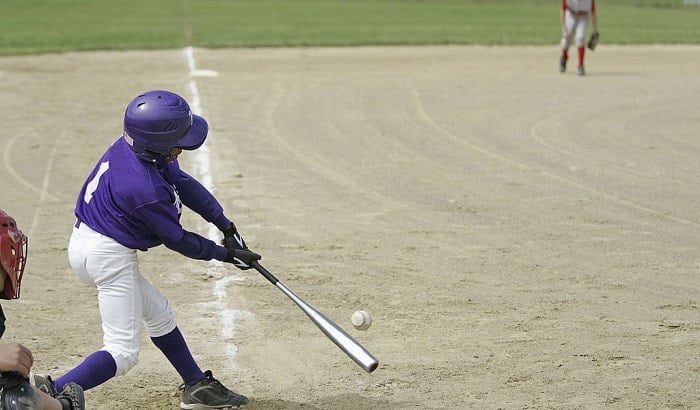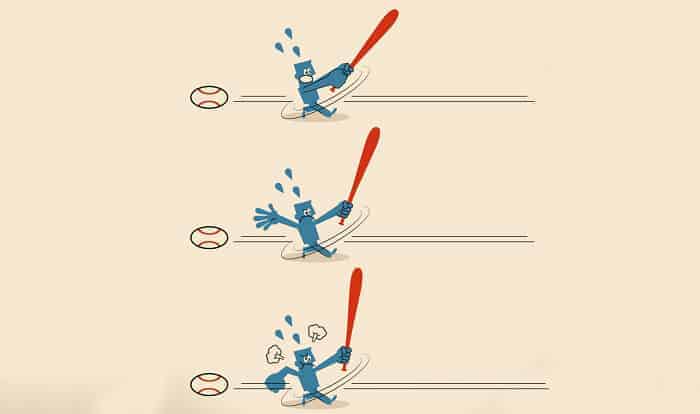The ultimate question, “who bats first in baseball,” rules out to be more important than you know. Lack of knowledge on basic rules related to this can cause delay.
While this subject may seem trivial, it covers basic moves in baseball. Thus, whether you are a fan or a player, you have to know this to appreciate the game entirely.
Moreover, securing an inning would prove impossible if the teams cannot decide who gets the first hand in batting.
Contents
Who Bats First in Baseball?
The “leadoff hitter” gets to bat first in a baseball game. Accordingly, this individual either belongs to the home or visitor team. Each team (offensive or defensive) consists of nine members.
According to basic baseball rules, the leadoff hitter or batter and the eight other members take turns in batting against an opposing pitcher in a designated sequence called the batting order or batting lineup.
When all nine have completed batting, with the leadoff hitter taking the lead, they will have presumably fulfilled a higher on-base percentage and thus have “batted around.”
Umpires take the second emergence of the leadoff hitter as a visual cue that one inning has concluded.
When Does a Visiting Team Get to Bat?
The visiting team bats in the first half of every inning, while the home team bats in the second half of every inning. Thus, the belief that the home team bat first is downright stereotypical.
Each half-inning, in this case, consists of three outs.
In a tournament, teams agree to a coin flip to identify who are the home team and the visiting team. Whatever the case, the visiting team always gets to bat first, and the home team bats second.
Who Determines the Leadoff Hitter?
The manager of the team determines the batting order and identifies the leadoff hitter. He must present his team’s batting order (via card) to the home plate umpire before the game begins.
His criteria for choosing the leadoff hitter and the rest of the batters in the order include:
1. Offensive Skill
The team’s batting sequence functions as one of its offensive strategies. Thus, the leadoff position requires a particular player that can sustain offense and defense in a short period.
Players who possess high strategic command deserve to take this position. The rest of the succeeding members nevertheless hold skills needed for the positions they have.
If the first batter takes the leadoff, the fourth batter assumes the “cleanup,” while the ninth assumes the “last.”
2. Effective Base Runner
The leadoff hitter aims to steal bases. For you to take a strong lead, a higher pitch count needs to come out. But reaching a base is never an easy feat.
This crafty move requires a combination of grit and wit to perfect. Ultimately, it can all run well if you are an effective base runner.
3. High Intuition
A lead hitter is the first person in the batter lineup. You must therefore set a solid batting cycle for your team while hitting the most plate appearances in your team.
To do this, you will have to develop your rhythmic intervals each time you walk towards the plate. Each interval should fall in the perfect timing to free the pitcher from making a run towards his team bench.
How Can You Become an Effective Lead Hitter?
To become an effective lead hitter (regardless of whether you are on a home or away team), you will have to develop the following skills:
1. Agility
Agility involves mental, physical, and visual coordination. In other words, you cannot have a responsive body with bad eyesight or delayed mental processing. All these parts must work together to be able to secure a perfect hit.
The ways to exercise agility for baseball hitting involve getting used to the highest number of pitches possible. Other exercises include doing hitting drills and hitting against a super-speed pitching tool.
2. Focus
The focusing skill takes a more complex nature than you know. It can be a tricky concept.
When you focus too much on the ball without minding the factors surrounding the bullpen or your swing technique, the chances are that you’ll end up missing it.
Whereas, when you properly focus on the ball and organize its motion, alongside other factors, in your head, you can deal with the ball.
Focusing is all about opening one’s senses and guiding one to receive an incoming stimulus.
It is, therefore, both a conscious and unconscious effort.
3. Expanded Vision
You are to obtain the highest vision grade possible. While 20/10 ranks as ideal, a 20/10 is doable.
Various means can expand your vision. But the most natural means is wearing prescription baseball glasses. Another excellent means for achieving excellent vision includes eye training and proper eye care.
4. Proper Baseball Swing Technique
This technique takes a complex set of biomechanics to complete.
But in summation, this swing technique dwells more on providing the body a sufficient ground for rotation to keep the head from turning to a degree.
When is a Hitter Out?
A leadoff hitter will be out when his hit falls in any of these categories:
- Strike Out: A strikeout occurs when the batter has had three strikes and is no longer permitted to hit the ball.
- Put Out: When the fielder has tagged a hitter with the ball right when he/she has failed to touch a base, the hitter is out.
Other causes for put-out include interference, flyout, tagout, forceout, strike-out, and appeal play.
- Field Out: Hitting the ball allows it to gain momentum to be caught by the fielder. Now, if you fail to hit it, you gain a strike as per the decision by the umpire.
However, the rules of the game will still give you a chance by allowing you three strikes. If by the third strike, you still fail, then you’re out.
In another case wherein a foul ball is involved, you are no longer allowed to take a third strike.
Conclusion
Inquiring about who bats first in baseball has always been a responsible gesture. Indeed, you cannot just hit balls without identifying the responsibilities assigned to members of a team.
During a match, the manager assigns the leadoff hitter to bat first. Both the home and visiting team have their leadoff hitter. The visiting team always hits first between the two groups, with the home team following in the bottom half of every inning.

Five years as a baseball player, my training approaches with this game give me the motivation to inspire and support young players more. Like all sports, we should start with the desire to have fun and maintain our resilience to strive better at any competition. But, of course, some of us want to have some fun and train for better health. It does not matter what your initial purpose is; I believe that most people ever holding on to the baseball bat will fall in love with the games as I do.
















